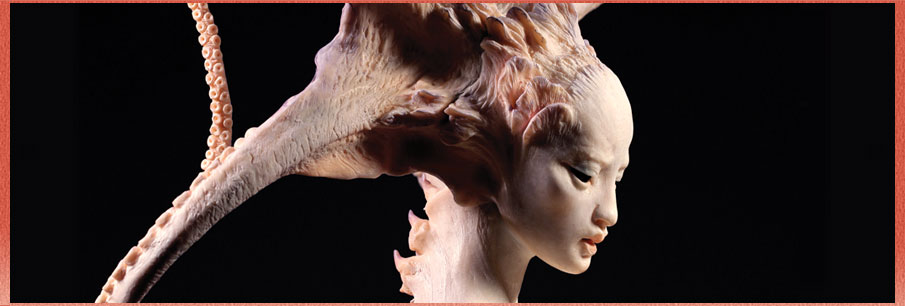
...or, making strong 3-D spiky things in polymer clay. This figure would stand about 8 inches in stocking feet. She flew to her new home via eBay, arriving undamaged.
My motto: Look like a butterfly, ship like a tennis ball.
To achieve this, one first needs a strong material. Amongst polymer clays, I recommend Kato Polyclay, Classic Fimo and Puppen Fimo. I understand Cernit is also quite strong, but I’ve not worked with it. No doubt there are others: experiment, and check out the enormous polyclay reference site, Glass Attic:
http://www.glassattic.com/
To test clay strength, I roll little ‘snakes’ (worms, if you prefer) as thin as my thinnest planned finger, tail, or other appendage, and bake them thoroughly. Then I set about bending and snapping them. Most informative. And I always make sure to cure a clay as long and hot as the manufacturer suggests. Under baked polymer clay is like ceramic greenware -- very fragile. Kato clay and the Fimos mentioned above all take long, repeated baking very well, though there may be some colour shift. Again, experiment.

Armatures: I armature everything, including fingers (many achieve beautiful fingers without armature, but... well, I need something to press against). Overall, an armature strengthens and supports, and in these winter faeries, each protrusion is built over wire. I now use a gold-plated or gold-filled wire, as this seems to help prevent verdigris. And for a tiny critter, it’s not too expensive.
To help the polymer clay adhere to the wire, I paint it with Gem-tac glue. That’s a white glue, that happens to be particularly good a clinging to nonporous surfaces. Sobo would do as well, if you can get it to cover the wire. I let the glue dry on the armature. The polyclay adheres well with dried white (PVA) glue.
Another good armature material: Aves Apoxie Sculpt, Fixit or Fixit Sculpt. Read about them at the Aves site: http://avesstudio.com/
I’m partial to the Fixit Sculpt. I cover an armature with it, then coat it with a PVA glue, as above. The polymer clay adheres well, is supported during baking, and, thus far, I’ve not had cracking problems (I watched for this, given the possibility of varied shrinking/cooling rates).
But enough for now. E-mail me if you have a question about this, and, despite cultivating a fashionable degree of ADD, I’ll aim to answer! Soon. Really.
